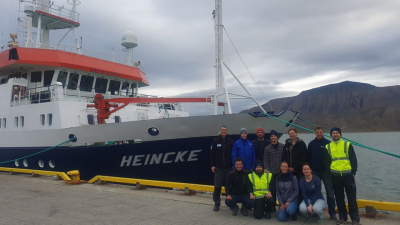- Home
- Discover
- Archive News
- News 2023
- Fjordgas
Inventory in Spitsbergen's fjords
The expedition with the research vessel HEINCKE starts on September 4 and takes the eleven-member research team to the fjords of Svalbard, Norway. "Gas seeps have already been detected off the coast of Svalbard, and now such systems have also been discovered in the fjords. Our goal is to systematically record gas seeps in the fjords," says Dr. Miriam Römer from MARUM - Center for Marine Environmental Sciences at the University of Bremen. She is leading the cruise, during which the team on board will primarily quantify gas seeps. How much gas escapes, how much dissolves in the water, what quantities emit into the atmosphere? "We will look at what the current actual state is and map the area. Our goal is to subsequently be able to make statements that are as valid as possible," says Miriam Römer. To do this, it would be necessary to quantify exactly where gas is escaping, which geological system underlies it, and how it must be included in a climate calculation. The exact gas quantities would have to be recorded selectively and comprehensively to be able to extrapolate a total budget for this region.
The occurrence of gas hydrates in the fjords of Spitsbergen has not yet been proven. However, according to Römer, modeling suggests that this is the case. Gas hydrates are stable under certain conditions; if the temperature or pressure in the ocean floor changes, they dissolve and release huge amounts of methane. "We want to prove for the first time that there are gas hydrates there before they dissolve," Römer says. He says the expedition is helping to better understand the entire gas system on site and under what circumstances it changes and how.
To do this, the team is using a mini-submersible robot to collect gases at water depths of up to 300 meters, as well as a sonar observatory, echo sounders, gravity corer and a multicorer for sediment samples.
More information on the expedition
Participating institutes:
MARUM - Center for Marine Environmental Sciences at the University of Bremen
University of Bremen
UNIS – The University Center in Svalbard, Norway
Contact:
Dr. Miriam Römer
General Geology - Marine Geology
MARUM - Center for Marine Environmental Sciences, University of Bremen
E-mail: [Bitte aktivieren Sie Javascript]



